Where to meet Geisha in Tokyo? Top 5 spots and tips

Have you ever heard of the word “geisha”?
Geisha are women deeply rooted in Japanese culture who have been elevating traditional banquets with their presence for centuries. They undergo years of rigorous training in various arts such as music, dance, tea ceremony, and conversation. Only after mastering these skills are they allowed to stand before guests, offering an elegant and refined form of hospitality.
Geisha are more than just entertainers—they are cultural icons who have quietly upheld Japan’s traditions and history. While many people associate geisha with Kyoto, Tokyo is also home to numerous geisha, particularly in areas like Asakusa and Shinbashi, where the rich culture of hanamachi (flower towns) still thrives. These areas offer a unique chance to experience this living tradition.
When you visit Tokyo, be sure to immerse yourself in this distinctive aspect of Japanese culture. Spending time with geisha is more than just sightseeing; it’s an opportunity to deeply appreciate the grace, elegance, and warmth of Japanese omotenashi (hospitality).
Their stunning kimonos, graceful movements, and refined manners embody the very essence of Japan’s traditional culture. By engaging with geisha in Tokyo’s hanamachi, you’ll not only gain a deeper understanding of Japan’s past but also create truly unforgettable memories.
So, if you find yourself in Tokyo, why not take the opportunity to experience this captivating cultural tradition by spending time with geisha? It’s an experience like no other, offering a glimpse into the elegance and beauty of old Japan.
- The history of geisha
- Meet Geisha in Tokyo! What is the history of the Hanamachi districts in Edo?
- What is Maiko Entertainment (Ozashiki Asobi)? Rules of Games to Remember
- 花街で芸者と遊ぶ際の注意点とは?
- 5 Geisha Districts in Tokyo That Still Exist Today
- Let’s learn more about geisha, a traditional aspect of Japanese culture.
The history of geisha
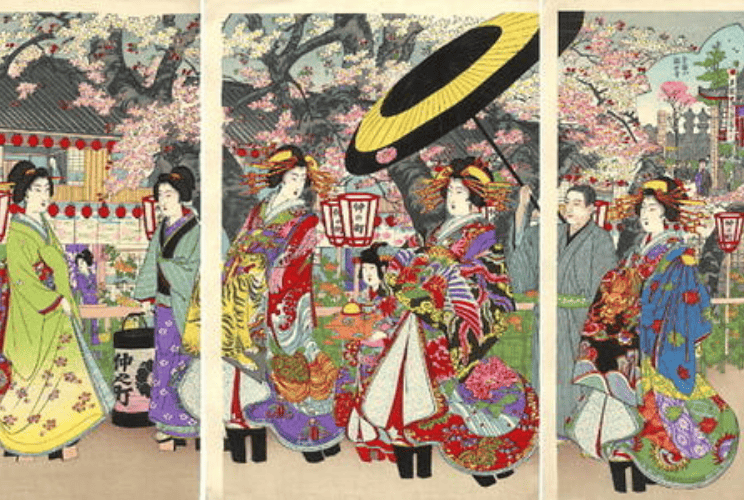
The history of geisha is deeply rooted in Japanese culture, with origins that can be traced back to the Heian period (794-1185). During this time, female entertainers known as “saburuko” and “shirabyoshi” performed for the aristocracy, showcasing their skills in singing and dancing. These early forms of entertainment laid the groundwork for what would later become the profession of the geisha. It wasn’t until the mid-Edo period (1603-1868) that geisha, as we know them today, began to emerge in cultural centers such as Kyoto and Edo (modern-day Tokyo). Initially, male entertainers called “taikomochi” or “hōkan” dominated the role of party hosts, but over time, female geisha became more prominent, specializing in traditional arts like music, dance, and tea ceremony.
During the Edo period, Japan experienced a time of peace and economic growth, leading to a demand for refined entertainment among wealthy merchants, samurai, and aristocrats. Geisha became highly sought-after for their artistic abilities, graceful movements, and refined manners. In Kyoto, these women were known as “geiko,” while in Edo, they were called “geisha.” They were far more than mere entertainers; they were cultural figures who upheld traditional Japanese arts and customs, earning them great respect in society.
In the Meiji period (1868-1912), Japan underwent significant modernization and Westernization, which had a profound impact on many aspects of society. While courtesans, such as the oiran, saw their roles diminish, geisha rose in prominence, especially as important figures at social gatherings for government officials and business elites.
However, the outbreak of World War II and subsequent social changes drastically reduced the number of geisha. Economic hardship and changing societal norms led to a decline in the hanamachi, the districts where geisha lived and worked.
After the war, misunderstandings arose during the American occupation, with some confusing geisha with prostitutes, a misconception exacerbated by the emergence of “geisha girls,” who were actually women in the sex industry misrepresenting themselves to Western soldiers.
Despite these challenges, the geisha profession survived and adapted. Today, geisha are still revered as cultural ambassadors, particularly in Kyoto, Tokyo, and other historical areas. Although their numbers have dwindled significantly from over 80,000 in the early 20th century to around 1,000 to 2,000 today, geisha continue to play an important role in preserving traditional Japanese arts.
They perform at banquets, entertain guests with music and dance, and participate in cultural events. Their training is rigorous, starting at a young age as apprentices, or “maiko,” where they learn not only the arts but also the etiquette and social skills required to succeed in their profession.
In conclusion, geisha are far more than entertainers—they are custodians of Japan’s cultural heritage. Although their numbers have decreased, their legacy endures, and they continue to be an integral part of Japan’s artistic and cultural landscape. The grace, elegance, and tradition they represent ensure that the world of the geisha, while transformed by time, remains a vital part of Japanese society.
What sparked international attention towards geisha?
The rise in international attention towards geisha began during Japan’s globalization in the late 19th and early 20th centuries, as the country engaged more with the West. A significant factor in this was Japan’s participation in international events such as World Expositions from the 1870s onwards. Japan took the opportunity to showcase its culture, and geisha became a central focus of this cultural display.
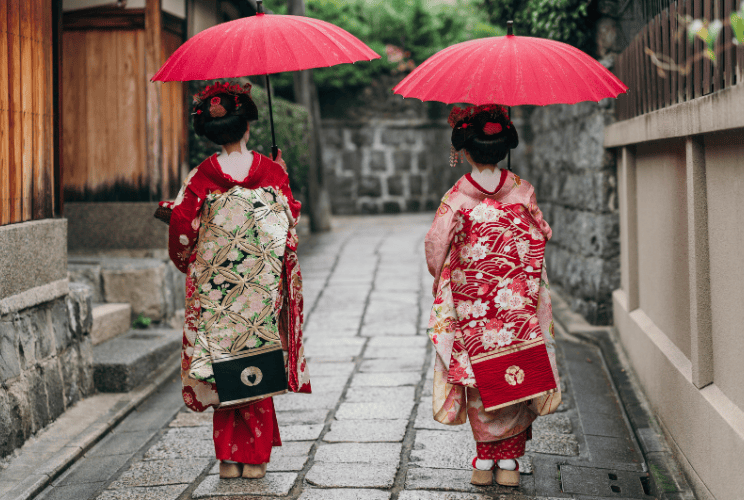
One of the most notable exhibitions was the 1873 World Exposition in Vienna, which marked Japan’s first large-scale participation in an international exhibition. Here, Japanese culture was presented to the Western public in full force. The Japanese government displayed traditional crafts, tea utensils, and elements of Japanese daily life and aesthetics. Geisha, as cultural icons, performed their traditional music and dance, with their refined movements and elegance making a strong impression on Western audiences. Geisha came to represent the exotic and graceful beauty of Japanese art.
The 1889 Paris World Exposition further cemented Japan’s cultural recognition on the global stage. Japan constructed replicas of Japanese gardens and tea houses, offering Western viewers a chance to experience the beauty of Japanese traditions firsthand. Geisha were also part of this display, performing in ways that left a lasting impression on European audiences, particularly in France.
The fascination with Japanese culture sparked by the exhibition led to the “Japonisme” movement in Europe, where Japanese art and aesthetics, with geisha at the forefront, became highly influential. Geisha became symbolic of the idealized image of Japanese women and beauty, establishing their status as cultural ambassadors of Japan in the West.
Through these international expositions, geisha evolved from being traditional figures within Japan to globally recognized cultural symbols. Western audiences were captivated by their elegance and the distinct beauty of Japanese culture, which played a significant role in sparking global interest in Japan’s cultural heritage.
Meet Geisha in Tokyo! What is the history of the Hanamachi districts in Edo?
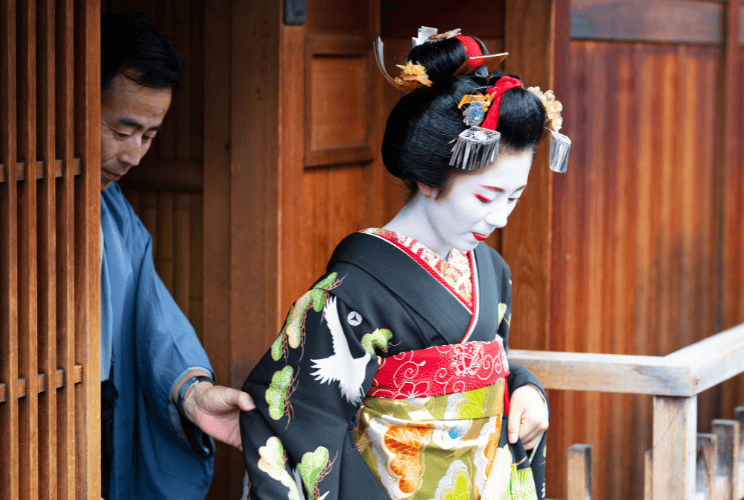
A hanamachi, or geisha district, refers to areas where geisha live and work, often centered around traditional restaurants and teahouses. In these districts, geisha entertain guests through refined performances that include music, dance, and conversation, after many years of rigorous training. The history of hanamachi in Tokyo dates back to the Edo period and continues to this day, with cultural traditions being carefully preserved.
In the early Edo period, districts like yūkaku (pleasure quarters) and okabasho (unofficial entertainment spots) emerged as centers of entertainment in the city. Initially, both courtesans and geisha coexisted in these areas, but over time, geisha came to specialize in traditional performance arts, such as shamisen playing and dance, distinguishing themselves from courtesans. These arts became highly sought after by the upper classes, and geisha soon gained prominence as skilled entertainers.
In Tokyo, hanamachi flourished in districts known as the “Six Hanamachi” or Rokkagai, which included areas like Shinbashi, Yanagibashi, Akasaka, Asakusa, Kagurazaka, and Mukōjima. Each of these districts developed its own unique traditions, and many geisha gathered there to perfect their craft and serve at formal banquets.
Shinbashi, in particular, rose to prominence in the late Edo and Meiji periods, becoming a prestigious district frequented by politicians and business leaders. The geisha of Shinbashi became known for their performance of Azuma Odori, a traditional dance event that still continues today. While Yanagibashi faded after World War II, other districts like Asakusa and Mukōjima have continued to uphold the geisha tradition.
Mukōjima, located along the Sumida River, became known for its scenic beauty, with guests enjoying both nature and the performances of geisha. Asakusa’s hanamachi grew around the theater district of Saruwakachō, where visitors could enjoy a combination of theater and geisha entertainment. Though many of these districts faced challenges due to war and economic changes, they were gradually rebuilt, and geisha culture remains vibrant in these areas today.
Even in modern times, Tokyo’s hanamachi districts remain integral to preserving Japan’s traditional culture. Special events, performances, and banquets still provide opportunities for visitors to experience the refined artistry of geisha. Visiting these districts offers a glimpse into a world of elegance and tradition, allowing people to connect with Japan’s cultural heritage on a deeper level.
What is Maiko Entertainment (Ozashiki Asobi)? Rules of Games to Remember
Ozashiki Asobi (Geisha entertainment) refers to traditional games and activities held during banquets or gatherings in Japan. These games serve not only as a source of enjoyment but also help to elevate the atmosphere of the event, bringing participants closer together. Led by geisha or maiko, these games are often accompanied by the sounds of shamisen and taiko drums, creating a rich and immersive experience filled with Japanese elegance and charm.
Geisha skillfully read the mood of the room and initiate these games at just the right moment to further liven up the gathering. With their refined techniques, they guide the flow of the event, suggesting games that help to ease tensions and bring smiles to everyone’s faces. These games often serve as icebreakers, helping to create a more relaxed and enjoyable atmosphere.
The rules of these games are generally simple, making it easy for first-time participants to join in. For example, games like “Tora Tora” and “Konpira Fune Fune” involve hand movements and are played to lively music, quickly energizing the room.
These traditional ozashiki games not only provide entertainment but also offer a unique opportunity to experience Japanese culture and history. Rooted in Japan’s long-standing tradition of hospitality, these games create unforgettable moments for everyone involved, offering a special glimpse into the country’s rich heritage.
‘Tora Tora’, a game similar to Rock-Paper-Scissors
The basic rules of the game “Tora Tora” are similar to rock-paper-scissors, but with a fun twist involving specific characters.
There are three roles in the game. The first is “Watonai,” the hero of Chikamatsu Monzaemon’s play Kokusen’ya Kassen, who is based on the historical figure Zheng Chenggong, a loyalist of the Ming Dynasty.
In the story, Watonai defeats a tiger but is weak against his mother. The second role is “Old Woman,” Watonai’s mother, who can defeat Watonai but loses to the tiger. The third role is “Tiger,” which loses to Watonai but defeats the old woman.
The game begins with two participants hiding behind a screen or another barrier so that they cannot see each other. To the accompaniment of music and dance, they perform various gestures.
At the end of the song, they emerge, acting out one of the three roles: Watonai (holding a gun), the Old Woman (leaning on a cane), or the Tiger (on all fours). Just like in rock-paper-scissors, the winner is determined by the relationship between the characters.
Before the game begins, participants also dance along with the maiko to the Tora Tora song. The maiko will guide you through the dance, making it a fun and engaging experience for everyone.
Konpira Fune Fune
In the game “Konpira Fune Fune,” two players sit facing each other with a small object, such as a sake bottle holder (called hakama), placed on a stand between them. The game is played to the rhythm of the folk song Konpira Fune Fune. Each player alternates placing their hand on the stand.
If the hakama is on the stand, a player can either grab it or leave it in place. When the hakama is present, the player must place their hand flat (palm open) on the stand.
If the hakama is absent, the player must make a fist and tap the stand. The game ends when one of the players makes a mistake—either using the wrong gesture (open palm instead of a fist or vice versa) or failing to follow the song’s increasing speed.
As the song speeds up, it becomes more challenging to keep up with the rhythm, making the game both exciting and tense. The fun lies in the strategic decision-making of whether to grab the hakama or leave it, all while staying in time with the rhythm.
Yakyūken
“野球拳” (Yakyūken) is a traditional Japanese game that blends music, dance, and janken (rock-paper-scissors) into an entertaining performance. It was originally developed as a form of folk entertainment and a festive activity performed at banquets, festivals, and within traditional ozashiki settings.
The game involves participants engaging in a lively dance, often accompanied by shamisen and taiko drums, while simultaneously playing janken to determine the winner. The dance and song are integral to the game, with players performing choreographed movements in rhythm with the music.
The origin of Yakyūken can be traced back to the Matsuyama Festival in Ehime Prefecture, specifically during the late 19th and early 20th centuries.
It is believed that the name “Yakyūken” (literally meaning “baseball fist”) came about because the game was first performed as part of a local baseball-related festival. Despite its association with the sport of baseball, the game itself is purely a form of entertainment that has no direct connection to baseball aside from its origins.
In the original form of the game, players simply danced and played janken to determine a winner, with no penalties or punishments involved. The primary focus was on entertainment and fostering a sense of community during social gatherings.
However, in modern times, especially due to its portrayal on television variety shows, Yakyūken has sometimes been depicted as a game where the loser removes an article of clothing after each round. This “strip Yakyūken” variation deviates from the original intent of the game and is more of a sensationalized, comedic adaptation. While this version is well-known due to its appearance in popular media, it is not representative of the traditional cultural significance of Yakyūken.
The game remains a beloved part of local festivals and social gatherings in Japan, where it is played in its traditional form, maintaining the charm of folk entertainment.
It is often viewed as a nostalgic and playful way to bring people together and create a lively, fun atmosphere. The music, dance, and competitive aspect of janken combine to make Yakyūken a unique part of Japan’s cultural heritage.
花街で芸者と遊ぶ際の注意点とは?
When foreign tourists wish to experience a geisha performance in a hanamachi (geisha district), it’s important to make reservations in advance.
Most hanamachi districts do not accept walk-in guests, and many places require an introduction or prior arrangement for entry. Therefore, it is advisable to book through a reliable guide or your accommodation to ensure a smooth process.
Once inside, maintaining a respectful attitude is crucial. During the banquet or geisha performance, it’s important to remain quiet and attentive, being careful not to disturb the atmosphere.
Geisha are highly trained professionals who have dedicated years to mastering their arts, such as singing, dancing, and playing traditional instruments. Their performances should be treated with the respect they deserve.
Tourists should also be mindful of the language barrier. While some geisha may speak English, many may not, so it’s helpful to learn a few basic Japanese phrases or arrange for a translator if needed. Regarding photography, tourists must exercise caution.
Taking photos without permission is considered impolite. Always ask for permission from the geisha or the host before taking any pictures, as this shows respect for their privacy and professionalism.
It’s also essential to understand the costs associated with geisha entertainment. Inviting geisha to an event can be expensive, and the fees usually cover the performance, food, and drinks. Additionally, it’s customary to offer a gratuity or a special tip, known as shugi. The host of the event can guide you on the appropriate timing and amount.
Respecting personal space is another key aspect of interacting with geisha. Behaving overly familiar or touching the geisha is seen as very disrespectful, and it’s important to maintain a courteous distance throughout the engagement. Upholding proper etiquette and being mindful of these cultural norms is fundamental to enjoying the experience and engaging with Japan’s traditional culture.
By following these guidelines, foreign visitors can participate in geisha entertainment respectfully, ensuring a memorable and culturally enriching experience.
Geisha and yūjo (courtesans) are different.
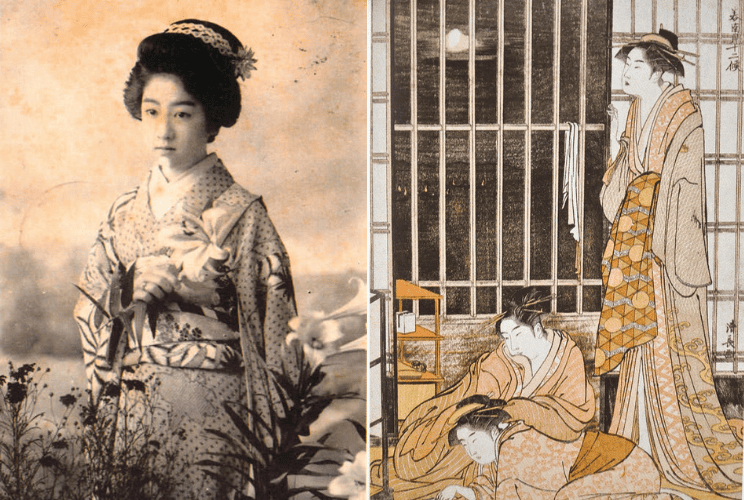
There are important points to keep in mind when enjoying maiko entertainment. One of the most important is understanding that geisha and yūjo (courtesans) are entirely different.
Geisha are highly trained professionals who specialize in traditional Japanese performing arts, such as dancing, singing, and playing the shamisen. Their role is to entertain guests at banquets through their artistic skills, and they hold a prestigious position as cultural performers. Geisha do not provide sexual services; instead, they embody the elegance and grace of Japanese culture through their refined gestures and impeccable manners.
On the other hand, yūjo were women who primarily worked in brothels during the Edo period, where their main role was to provide sexual services. While some yūjo, especially high-ranking courtesans known as oiran, were well-versed in arts and etiquette, their primary duty was to engage in sexual relations with clients.
The fundamental difference lies in the fact that geisha sell art, while yūjo sold sex. Geisha are purely cultural performers whose purpose is to entertain through traditional art forms, while yūjo were part of the entertainment industry’s sexual services.
Therefore, when participating in geisha entertainment, there are no sexual services involved. It is important to never demand such services or engage in inappropriate behavior, as this would be highly disrespectful. The focus should be on enjoying traditional Japanese arts, such as dance and music.
5 Geisha Districts in Tokyo That Still Exist Today
While Tokyo is famous for its modern skyscrapers and the latest trends, it also boasts many places that still convey traditional culture and charm. Among these are the geisha districts—special areas where you can feel the history and performing arts that have continued since the Edo period.
These neighborhoods, where many geisha once honed their skills and captivated audiences, still retain traces of their past even today. Just a step away from the hustle and bustle, you can wander through back alleys filled with buildings and scenery that quietly mark the passage of time, allowing you to experience Japan’s aesthetics and traditions firsthand. This time, we’d like to introduce ten geisha districts in Tokyo that continue to preserve their unique allure.
Akasaka
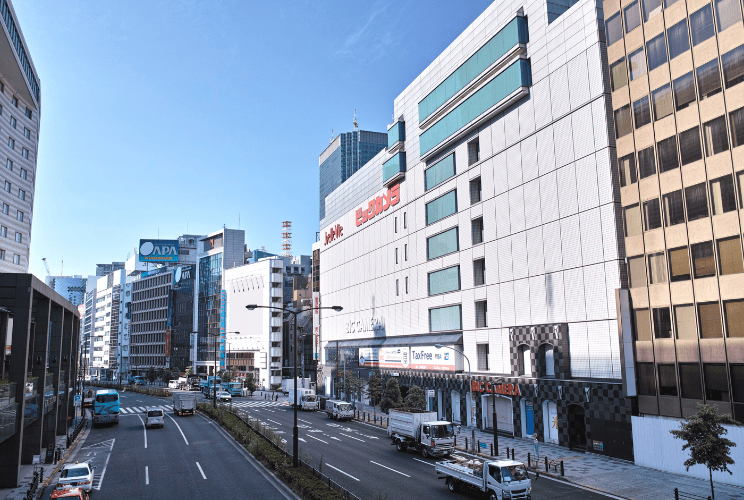
The Akasaka geisha district, known as Akasaka Karyūkai, has a rich and storied past. While the exact origin of the name “Akasaka” isn’t certain, several theories exist. One suggests that the area was characterized by slopes made of red soil.
Another theory points to the abundance of madder plants (called akane-gusa in Japanese), leading people to refer to the area as “Akane-yama” (Madder Mountain), with the slope ascending it becoming known as “Akasaka” (Red Slope). A third idea is that the red soil found in the lower residence of Lord Matsudaira Akinokami inspired the name. Despite these theories, the true origin remains a bit of a mystery.
The district’s history began around a large reservoir called Tamike, which was surrounded by the residences of many feudal lords. Tamike was famous for its beautiful scenery, especially the fireflies that lit up the area at night, making it a popular spot for visitors.
As people were drawn to its picturesque views, tea houses started to spring up around the reservoir. Over time, these evolved into unofficial red-light districts known as “okabasho.”
However, it wasn’t until the Meiji period that Akasaka became an official geisha district. During this time, it was mainly frequented by military personnel and politicians. At its peak, the district was home to about 400 geisha. One particularly famous geisha was Manryū, who became so popular that her photographs sold out completely.
By around 1955 (Showa 30), Akasaka had about 300 geisha and 80 teahouses. But as bars, nightclubs, and cabarets began to increase, and as criticism grew over politicians engaging in what’s known as “waiting-room politics,” the geisha district started to decline. By 2007, only six teahouses and about ten geisha remained in Akasaka.
In 2009, a teahouse called Kinryū, which had closed four years earlier, reopened with a new business model, sparking renewed interest in the area. This revival, along with events like the “Akasaka Odori” dance performances, has helped the district gradually bounce back.
Initially popular with military officials in the early Meiji era, Akasaka later became a hub for bureaucrats. Although the banning of “official-to-official entertainment” and the bursting of the economic bubble led to its decline, the area is once again showing signs of revitalization today.
Asakusa
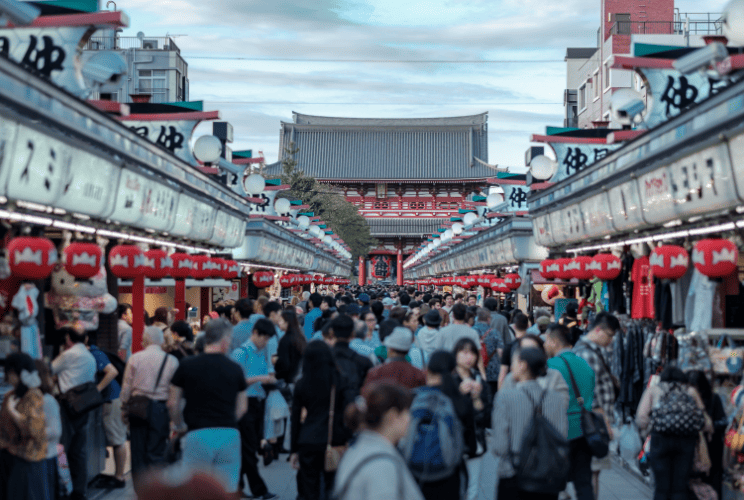
The geisha district of Asakusa preserves the rich atmosphere of Tokyo’s old downtown, filled with history and tradition. The exact origin of the name “Asakusa” isn’t clear, but one theory suggests it means “a place where the grass is shallow” in the once densely grassy Musashino area. Senso-ji Temple, the oldest temple in Tokyo, is located here and is also known by its mountain name, Kinryuzan.
You can see the characters for “Kinryuzan” above the large lantern at the Kaminarimon Gate for this reason. Incidentally, the official name of Kaminarimon is “Fujin Raijin Mon” (Gate of the Wind and Thunder Gods), featuring statues of the wind god on the right and the thunder god on the left as you face the gate.
Situated in one of Tokyo’s most famous tourist spots, the Asakusa geisha district hosts numerous local festivals. Notably, the Sanja Festival held in May attracts about 1.5 million visitors over three days and is renowned as a major event where you can experience Asakusa’s traditional culture firsthand. Additionally, as of 2015, the district is home to Yuko-san, who at 93 years old is the world’s oldest active geisha, recognized internationally for her enduring presence.
Moreover, Asakusa’s geisha district is unique for having entertainers known as “hōkan.” Hōkan are performers who showcase their own arts at banquets and gatherings, supporting geisha and maiko to enliven the atmosphere. Typically male and also called “taikomochi” or “male geisha,” there are now female hōkan active as well. While they were once thought to exist only in Asakusa, this tradition has been passed down in other regional geisha districts too.
In addition to the geisha district, there are professionals known as “furisode-san” who add a touch of glamour to social gatherings involving drinks. These young women bring vibrancy and elegance to events, playing a role in the unique cultural tapestry of Asakusa.
Kagurazaka
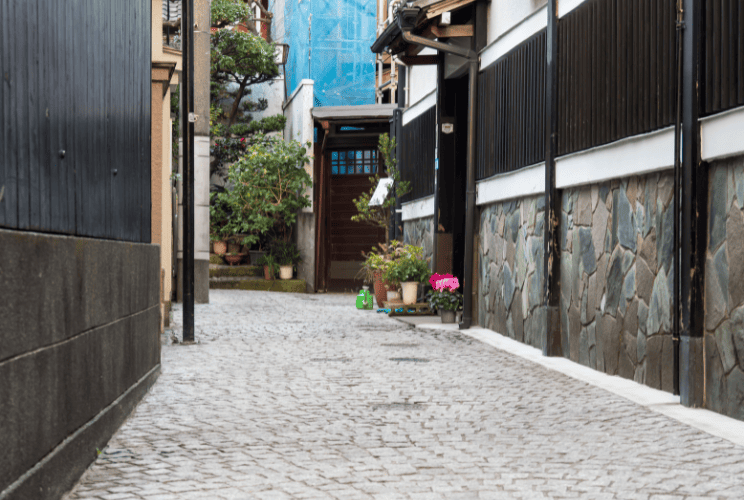
The geisha district of Kagurazaka is one of the areas in Tokyo that retains a strong sense of history and tradition. The origin of its name is not clear, but theories suggest it may be due to the presence of a “kagura hall” nearby or because portable shrines visited the area during festivals, accompanied by kagura performances (traditional Shinto music and dance). From the Edo to the Meiji period, Kagurazaka flourished as a geisha district, where many geisha honed their arts daily and showcased their skills.
Since 1963 (Showa 38), the “Kagurazaka Odori,” where geisha present the fruits of their daily practice, has been held annually. This event was recognized as the first Regional Cultural Property of Shinjuku Ward, playing an important role in preserving and passing on the area’s traditional culture. However, it was not held in 2016.
The Kagurazaka geisha district is known for its strong ties with the local community. Staff from the Ushigome Police Station and Ushigome Fire Station set up booths at the “Kagurazaka Odori” to conduct crime prevention and fire safety awareness activities. Additionally, Kagurazaka’s geisha actively participate in community events such as fire drills and AED training, establishing a system of mutual cooperation.
Furthermore, Kagurazaka is characterized by its atmospheric streets lined with cobblestone alleys and historical buildings, attracting many tourists. The area boasts numerous traditional Japanese restaurants and ryotei (exclusive Japanese dining establishments), making it a popular place to experience geisha culture firsthand.
Shinbashi

The Shinbashi geisha district is one of Tokyo’s most renowned traditional geisha areas, boasting a rich and profound history. The name “Shinbashi” is said to originate from the “New Bridge” that once spanned the Shiodome River (also known as the Shinbashi River). This bridge was located just south of what is now the Ginza 8-chome intersection.
In a narrow sense, “Shinbashi” refers to the area from Shinbashi 1-chome to Shinbashi 6-chome. However, in a broader sense, it includes the entire region encompassing neighboring Shiodome (Higashi-Shinbashi in Minato Ward) and the former Kobiki-cho (the eastern part of Ginza in Chuo Ward). Landmarks like the Shinbashi Enbujō theater, Shinbashi geisha, and the district’s traditional restaurants fall under this broader definition of Shinbashi.
The name “Ginza” originally wasn’t a place name but derived from the name of an Edo-period government office called “Ginza,” which was responsible for minting silver coins in the area. This name eventually became established as the place name. Similarly, the “Kinza,” where gold coins were minted, was located in what is now Nihonbashi in Chuo Ward; the site is currently occupied by the Bank of Japan.
Shinbashi’s geisha district is celebrated as “Shinbashi of the Arts,” renowned for its refined performances. It is home to the Shinbashi Enbujō theater, where the annual “Azuma Odori” performances are held.
Starting with the 90th Azuma Odori in 2014, three traditional dance schools—Nishikawa-ryū, Hanayagi-ryū, and Onoe-ryū—have taken turns directing the performances, showcasing stages with unique characteristics each year. This approach allows them to continue introducing new charms while preserving tradition.
The geisha of Shinbashi are highly regarded both domestically and internationally for their advanced skills and spirit of hospitality. The traditional restaurants and sophisticated streetscape offer visitors a special experience, continuing to preserve the culture and arts even in modern times.
Hachiouji
The Hachioji geisha district is located in the western part of Tokyo and is known as the only geisha district outside the city’s 23 central wards. Hachioji City is the largest city within Tokyo in terms of area, and its name is said to originate from the “Eight Princes.”
This refers to the eight children (princes) of Gozu Tenno, a deity traditionally believed to govern health and good harvest. The Hachioji Shrine, which enshrines these deities, is also located within the city.
Held annually in August, the “Hachioji Festival” is the city’s largest event, attracting over 700,000 visitors over three days. It is cherished as a venue where people can experience the region’s traditions and culture firsthand.
In recent years, the Hachioji geisha community has been featured more frequently in the media, and the number of geisha has been on the rise. These developments have greatly contributed to the revival and preservation of traditional performing arts in the area.
Currently, there is no official website for the Hachioji Geisha Association, but the website of the geisha house “Yukinoe” provides detailed information about the history and activities of the Hachioji geisha district. The geisha of Hachioji continue to uphold traditional Japanese performing arts, sharing their charm with visitors.
Official website of Geisha House “Yukinoe”: http://yukinoe.net/
Let’s learn more about geisha, a traditional aspect of Japanese culture.
Geisha, emblematic of traditional Japanese culture, captivate people worldwide with their elegant dances and refined hospitality. When you visit Japan, be sure to explore the geisha districts to immerse yourself in their rich culture and artistry.
By experiencing this tradition firsthand, you’ll gain a deeper understanding of Japan’s history and aesthetic sensibilities, creating unforgettable memories. We’ve introduced five areas in Tokyo where you can enjoy time with geisha; please consider adding them to your travel itinerary.
Additionally, Best Escort Tokyo features beautiful women who are just as enchanting as maiko (apprentice geisha). If you’re seeking Japanese escorts, please feel free to contact us.
Leave your evening entertainment to us.




